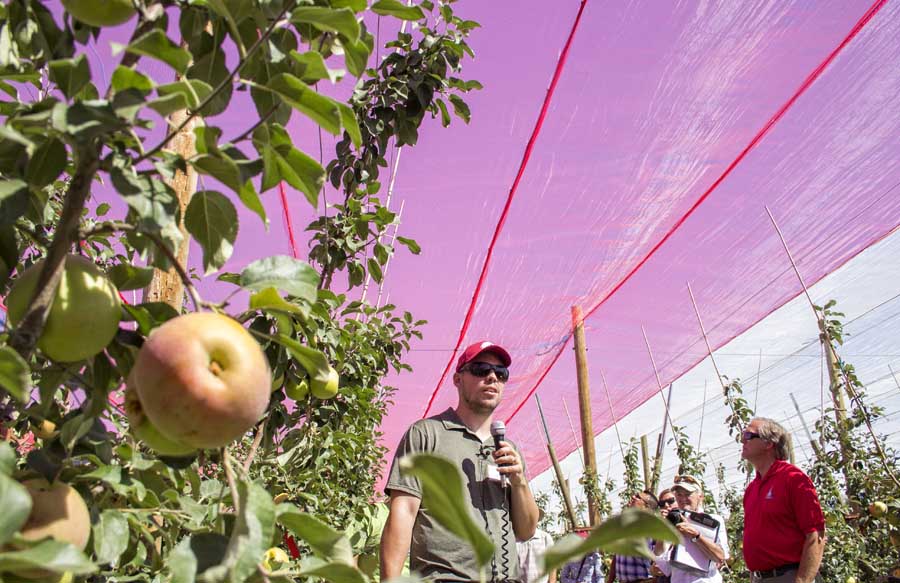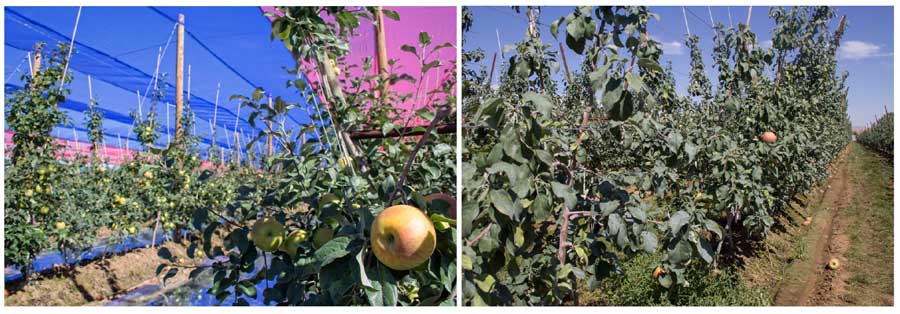
Lee Kalcsits, Washington State University assistant professor of tree fruit physiology, talks about his research results into the benefits of anti-hail netting during a field day in August. WSU has installed red, blue and pearl netting at this fourth-leaf Honeycrisp orchard owned by McDougall and Sons near Quincy, Washington.(Shannon Dininny/Good Fruit Grower)
Washington State University researchers are finding that photo-selective, anti-hail netting can provide additional benefits, particularly in orchards that receive intense sunlight, in just the first two years of a multiyear study.
In previous studies, orchard netting has been shown to protect against hail, wind and intense light.
Researchers now are examining the long-term effects of netting on not just tree growth, but also photosynthesis, responses to tree stress and fruit quality in terms of color, maturity, size and storability.
Red, blue and pearl netting have been installed at a research orchard in Wenatchee, Washington, and at a 12-acre McDougall and Sons block of Honeycrisp trees on Budagovsky 9 rootstock in their fourth leaf near Quincy, Washington.
Remotely monitored sensors measure air temperature and humidity just under the netting as well as inside the tree canopy, wind speed, light intensity and soil moisture and temperature at depths of 8 and 16 inches.
In the first two years of study, all three colors of netting reduced overall light in the canopy up to 25 percent when compared with a control orchard with no netting.
In addition, although overall and direct light were reduced, netting increased the scattered or diffused light, resulting in an increase in canopy volume by 15 percent.
That is a significant finding for the project, particularly for varieties like Honeycrisp that can be difficult to grow, Stefano Musacchi, WSU endowed chair and associate professor of tree fruit, said during a field day at the Quincy site in August.
“The net can increase the way you can fill up your space in a fast way in the beginning,” he said. “Net is really effective in manipulating the capacity of the tree to grow.”
Lee Kalcsits, WSU assistant professor of tree fruit physiology, said the researchers thought they would see a reduction in temperature under the netting, in part because it feels cooler than outside the netting.
But they discovered that overall air temperature and humidity did not change. What did change was the amount of energy reaching the surface.
As a result, they found that trees were more productive for longer during the day under the netting, with photosynthesis occurring a little longer into the day past noon.
In addition, while leaves can transpire to regulate their temperature, fruit doesn’t have that ability, resulting in sunburn.
The research showed that the fruit surface temperature was only 7 degrees Fahrenheit higher than the air temperature under the netting, compared with 20 degrees higher outside.
The result: In 2015, between 5 and 8 percent of the fruit underneath the netting experienced sunburn, compared with 25 percent of the fruit outside the netting.
No evaporative cooling was applied. In 2016, although the incidence of sunburn was reduced in the control through evaporative cooling, sunburn severity was still reduced in the netting compared to evaporative cooling.
The soil also absorbs a lot of energy, and Kalcsits said the researchers were interested in the impact of netting on soil temperature and moisture.
Overall, they found that netting decreased soil temperature by as much as 4 degrees, which he noted was substantial when soil temperatures can reach 88 degrees (31 degrees Celsius) in some places during the summer.
“Eighty-eight degrees Fahrenheit is a pretty stressful environment for roots to grow. We’re doing some work to see what impact those temperature changes have on root growth in the soil and how that translates to overall tree growth and tree performance,” he said.
The researchers found that netting also reduced wind speed by 40 percent, which could help reduce wind damage, especially close to harvest, Kalcsits said.
Effects on the fruit

A control block without netting, above, shows poor return bloom compared with a block under blue netting, at left. (Shannon Dininny/Good Fruit Grower)
Kalcsits said he saw a 15 percent increase in fruit size last year underneath the netting and an overall improvement in return bloom regardless of net color.
“Color just fine-tunes the differences. They may be significant, but it will take two to three years of data to really examine those differences,” he said.
After two years of fruit quality results, they have found no significant differences in fruit quality under the netting compared to the uncovered control.
However, because of the different light environment and changes in fruit growth and slight changes in maturity, the management of orchards under netting will need to be different than an uncovered orchard.
The final year of the project will seek to identify some of these factors.
Grower Scott McDougall noted one specific preference among the colors.
“Pickers don’t like working under the red netting,” he said. “It’s a brighter environment, and it feels hotter. They like the blue because it feels cooler.”
The cost of netting is about $3,000 per acre, just for the material alone, plus the cost of installing the structure and labor.
The $410,000 project is being funded through grants from the Washington Tree Fruit Research Commission and the U.S. Department of Agriculture’s Specialty Crop Block Grant Program.
Kalcsits will present the findings from the first two years of his study at the Washington State Tree Fruit Association’s annual meeting. •
– by Shannon Dininny






Leave A Comment